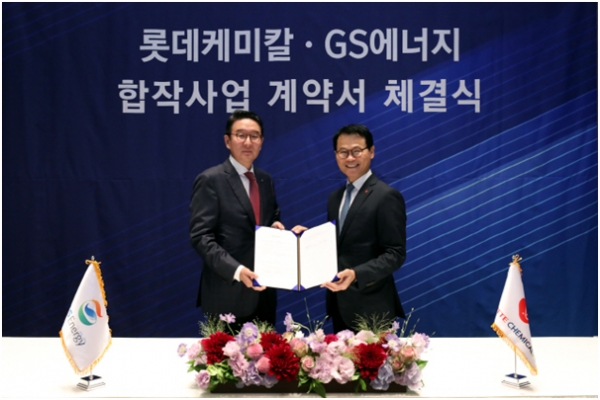A Win-win Partnership

GS Group is joining hands with Lotte Chemical Corp. to strengthen its petrochemical business. Lotte Chemical is partnering with GS Group in addition to Hyundai Oilbank Co. to secure a stable supply of petrochemical compounds.
GS Energy Corp. announced on July 15 that it has agreed with Lotte Chemical to create a joint venture, tentatively named Lotte-GS Energy Co., this year to produce bisphenol A (BPA) and C4 fraction. The two companies plan to complete the establishment of the joint venture within the second half of this year. Lotte Chemical will have a 51 percent stake in the new entity, with GS Energy owning the remainder.
The two firms will jointly invest a total of 800 billion won (US$677.97 million) by 2023 to build a plant on the premise of Lotte Chemical Yeosu Plant 4. The new facility can produce 200,000 tons of BPA and 210,000 tons of C4 fraction products a year. BPA is used to make polycarbonate plastics whose applications range from electrical and electronic devices to medical equipment and auto headlamp cases. C4 fraction is a hydrocarbon compound used to produce butadiene, a material for making synthetic rubber, and tert-butyl alcohol (TBA), which goes into engineered marble. They expect the joint venture to generate 100 billion won (US$84.75 million) a year in operating profit and 1 trillion won (US$847.46 million) in sales, as well as directly and indirectly create 7,700 new jobs.
GS Energy and Lotte Chemical expect the joint venture to help sharpen their competitive edge in their respective businesses. Lotte Chemical will be able to attain BPA supplies from the joint company to make its polycarbonate products more price competitive. The joint venture will also help the company achieve an economy of scale in its C4 fraction business.
GS Energy will be able to improve its profitability as it can supply propylene, benzene and C4 fraction to the joint company through GS Caltex Corp., a refining company 50 percent owned by it.
With the establishment of the joint venture, industry analysts believe that GS Group will accelerate the shift of its focus from the oil to the chemical sector. GS Caltex plans to produce 700,000 tons of ethylene and 50,000 tons of polyethylene a year through its mixed feed cracker (MFC), which is being built in Yeosu with an investment of 2.70 trillion won (US$2.29 billion), starting from 2021. The plan is based on its judgment that it cannot earn enough profits with a refining margin alone. The refining business accounted for only 53.5 percent of the company’s total operating profits, while it took up 85.5 percent of its total sales, according to the GS Caltex’s business report last year. On the other hand, the petrochemical business accounted for 31.3 percent of its operating profits despite its share of the total sales stood at only 11.8 percent. In particular, about 40 percent of GS Group’s net profits came from GS Caltex. Therefore, GS Caltex’s performance has a great effect on GS Group as a whole.
In addition, Lotte Chemical is seeking to increase its profitability by achieving an “economy of scale” through its subsidiary in Malaysia and ethane cracking center (ECC) in the United States. However, a stable supply of naphtha and ethanol, which are raw materials of petrochemical products, is essential. This is why Lotte Chemical is working hard to carry out a joint business with refining companies. Lotte Chemical set up “Hyundai Chemical” with Hyundai Oilbank in 2014 to strengthen its value chain between raw materials and petrochemical products. Lotte Chemical holds a 40 percent interest in the joint venture, with the rest owned by Hyundai Oilbank. The company’s latest agreement with GS Energy is also aimed at reinforcing its value chain.


